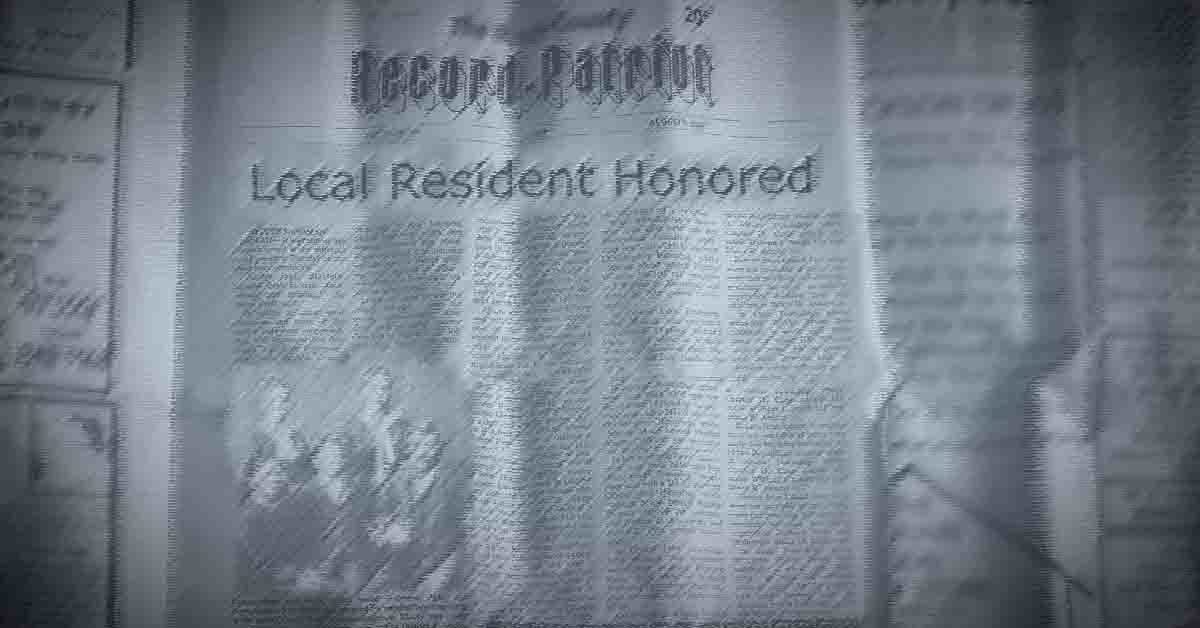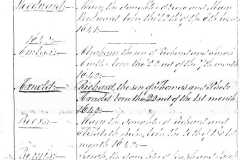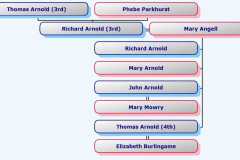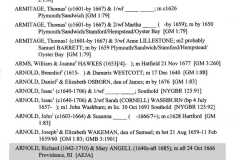Richard was born in Watertown, Middlesex, Massachusetts, USA on Friday, March 22, 1642 to Phebe Parkhurst and Thomas Arnold (Immigrant).1
1650’s
Richard was about the age of 12 when his parents moved from Watertown to Providence.
1660’s
On June 4, 1666, it was agreed that Richard would be reimbursed for the King’s use of his horse:
It is ordered by the town, that Richard Arnold shall be paid for the hire of his horse, which was prest about a yeare agone for the Kinges Service
Early Records of the Town of Providence, Vol 3, p. 84.
Richard married Mary Angell around October 24, 1666, and they had their first child, Richard, in 1667, perhaps a little too soon after the wedding:
His marriage probably took place shortly after 24 Oct. 1666, when he and Mary Angell were fined 40 shillings for fornication. … The children of Richard and Mary were: Richard, b. 1667 …
Some Arnolds of Smithfield, Rhode Island History Journal, Volume 13, p 113.
Fornication at the time was punishable by whip (“publiquely whiped”) or fine, per the notes of the General Court of Commissioners, held at Newport, May the 19th, 1657:
It is ordered, that any person convict of the act of Fornication within the jurisdiction of this Collony, shall be publiquely whiped in the Towne where the fact was done, with fifteene stripes for the first offence, or pay forty shillings; and in case of a second, in that case the party shall be publiquely whiped at the towne where it was done if on the Island; and of the other Towne of the Island a week after, with fifteene stripes at each place; and soe if on the maine land, then at the towne where it was done; and at the next towne alsoe to receive the like punishment as is aforesaide, or pay a fower pound fine to the Collony Treasury.
Records of the Colony of Rhode Island, Vol 1, John R. Bartlett, 1856, p 355.
Children of Richard and Mary:
- Richard Arnold 1667-1745 (78)
- Mary Arnold 1668-1735 (66)
- John Arnold 1670-1756 (85)
- Thomas Arnold 1675-1726 (50)
Captain Richard Arnold probably never lived at Woonsocket, but, after the customs of those times, improved his lands, coming from his home in the Providence settlement. In this way he had built his saw mill, at the “falls,” in 1666, before the death of his father, Thomas Arnold.
History of Providence County Rhode Island, Vol 2, Richard M. Bayles, 1891. pp. 268-9.
Their second child, Mary, was born in September of 1668.
1670’s
A son, John, was born to Richard and Mary in November of 1670.
Richard built a number of saw mills during his life:
Richard built the first of many sawmills to be operated by the Arnold family in partnership with John Scott on the Moshassuck River in 1673.
The Arnold Family of Smithfield Rhode Island, Richard H. Benson, 2009, p. 15.
Richard’s father, Thomas, died in September of 1674, after which the Providence town council divided his estate and lands between Richard and his siblings:
The Smithfield part of Woonsocket was originally a part of Providence, one of whose early proprietors was Thomas Arnold, who died in September, 1674. His estate was divided by the town council of Providence between his widow and the five surviving children. This estate included lands in the northern part of the state, in what became, the town of Smithfield. Richard Arnold was the oldest of his children, and his sister Elizabeth was married to Samuel Comstock. To these two were allotted the upper Smithfield lands, and by them were the first improvements made.
History of Providence County Rhode Island, Vol 2, Richard M. Bayles, 1891. p. 268.
Richard and Mary had their last son, Thomas, in March of 1675.
King Philip’s ongoing war with the Native Americans caused most residents to flee Providence in 1675 for Portsmouth or Newport. Richard’s brother Thomas was among 27 men to stay:
A list of 27 names of such as stajd & went not away, was presented, unto whome these Jndjans should be due, ye names were … Tho Arnold …
Early Records of the Town of Providence, Vol 8, p. 12.
Richard returned to Providence with his family after the war.
1680’s
Not knowing his descendants (e.g. Daniel Webster Arnold and Daniel Simon Arnold) would make a living cutting trees in Michigan and Wisconsin two centuries later, Richard continued to build saw mills:
About 1680 he turned his attention to building sawmills. He had one in Woonsocket, Rhode Island, that year and in 1700 built one in Providence on the Woonasquatucket River, five miles above the salt water harbor.
Some Arnolds of Smithfield, Rhode Island History Journal, Volume 13, p 113.
In April of 1682, 40 year old Richard testified about the drowning death of a native woman in a canoe accident:
Richard Arnold agreed [aged] about 40 yeares testifieth and saith I being one the third of April going from my home porposeing to goe to Seaconk met my jndian man called Sam who came then from my seller att the new feelds. I asked him whether the canow ware there that I might goe over the river he told me it was by the seller when he came away. When I came to the seller, there was 3 squaws and thay told me an jndian had caried the canow over the river and was gone. But the squaw called Marget, Sams sister, told me there was a bark canow that I might goe over in. I went out and out and saw it and came in to the seller againe and told her I never went in such a canow and I did not like it, thinking I must goe vp to the falls to goe over.
Early Records of the Town of Providence, Vol 15, p. 239
But shee told me that two men came over in that canow last night, and presently went out of the seller, and I went out quikly after her and saw her puting the canow into the water. I saw it leaked and said if shee went in that over the river shee had best take a dish to throw out the water if much came in. But shee toke none, but put ofe the bark canow specking to the other two squaws which I vnderstod not, and went to goe over the river. I saw when shee was aboue halfe ouer the river the canow swome deep and shee paddeled toward the other side but before shee came neere the shore shee left the canow and went to swiming. Then I hallowed thinking posible there might be some body one the other side might help her with the other canow but no body came and I kept hallowing till shee sunk vnder water and rose no more that I saw.
Captain Richard was active in government for many years:
He was a Governor’s Assistant (member of Upper House) 1681-86, ’90, ’94, ’99; Deputy to the Rhode Island General Assembly, 1671,’76, ’79-’81, ’96, ’98, 1700-2, ’05, ’07-8; Speaker of the House of Deputies, 1707-8; Member of the Providence Town Council, 1700-1.
Some Arnolds of Smithfield, Rhode Island History Journal, Volume 13, p 113.
Richard announced plans to marry the widow Sarah Smith in November of 1687. Sarah’s maiden name and birth date is unknown. She died in 1712:
In November 1687, Richard published banns in Providence to marry Sarah Smith. She was probably the widow of John Smith, the miller, and died in 1712. John Smith, the miller, had died before 2 June 1682, when his widow Sarah and son John posted bond to be executors of his estate.
The Arnold Family of Smithfield Rhode Island, Richard H. Benson, 2009, p. 14.
1690’s
Richard’s first wife, Mary died in 1695.
In April of 1697, during King William’s War, Richard Arnold and others were directed to search and patrol the land beyond their plantations for “Indian Enemies”. This is likely when he began being referred to as Captain:
Whereas there hath bin a late incurtion & invation made vpon some of our English plantations by the Cruel and Barborous Jndian Enemies, whose tender mercies are cruel, and considering the dainger of manie of our neighbours who liue remote from our town wee the councel of war for the town of Providence haue thought fitt in his Majes”” name to nominate and appoynt you Richard Arnold [and 19 others].
Early Records of the Town of Providence, Vol 17, p. 163
Euery of you to take the comand and conduct of ten men as they are seuerally named in your seuerall Lists, and with them to rainge beyound the outmost of our plantations. Each of you two daies at a time or more as need shall require, to serch after the enemies, and vpon discouery of anie of them you are according to the best of your skill to indeuour to resest expulse kill and distroy them accoring to the best of your jndeuour.
But in cace you judge them to be two strong for you, you are to alarem as manie of our inhabittants as in yo wisdom yu can or may, you are allsoe to obserue such directions and instructions as shall be from tim to tim giuen you by the counciel of war aforesd, and in case anie of your company should neglect or refuse to goe vpon sd seruice, haueing had sufHcient notis thereof you are, impowered to take as a fine three shillings for euery days neglect and in soe doing this comission shall be your warent and discharge.
Signed by order of the Counciell of war for the town of Prouidence, this 24th of Aprill, 1697
1700’s
In 1707, Richard and four of his contemporaries were together granted 1,000 acres in an attempt to discourage and prevent “incursions” into the norther portions of Providence:
Whereas there is an Expectation that by some persons there will be some intrusion made upon the lands of our Towne of Providence in the Northerne Part of our Plantation, therefore in order for a preventing of the same the purchassers & proprietors of the lands of sd Towne of Providence do grant unto Major William Hopkins, Captn Richard Arnold, Mr Jonathan Sprague, Mr Joseph Whipple, & Ensigne Samuell Comestock to have one thousand acres of land laid out unto them in the Northerne Part of our Towneshipp, all of them to be equall sharers in the same, & the same to hold by vertue of a title from the purchassers & proprietors of said Providence, and to vindecate said title at their owne proper cost & charge against all intruders whatsoever, & the same to defend by all lawfull wayes & meanes; endeavouring to the best of their vnderstandlngs, so farr forth as they can, or may, to prevent any intrenchment upon, or inroade to be by any person or persons whatsoever intrudeing made into any place of the northerne part of sd Providence Plantation.
…
But if they shall moete with such discouragements, & obstructions whereby they shall see cause to decline the matter & desist from further prossecuton therein, then all the aforesd land so granted shall returne againe & be unto the purchassers & proprietors of sd Providence as it was before sd grant was made.
But if they shall persue the matter & prossecute the same to a full period as premised, then all the sd thousand acres of land shall be unto the said five persons to them their heirs & assignes forever. At a towne meeteing May ye 19th 1707 the above written instrument is by the purchassers & proprietors of Providence granted, and is by the above sd five grantees accepted before us.
Joseph Williams Assistant, Thomas Fenner Assistnt (Verso) The Northern Grant to ye 5 Persons.
Early Records of the Town of Providence, Vol 17, pp. 228-9
1710’s
Richard passed away in Providence, Providence, Rhode Island, USA on Tuesday, April 22, 1710 at the age of 67.
His will, dated June 8, 1708, was not witnessed, but was ultimately approved 10 May 1710. The will included provision for his wife, Sarah, and split various properties, including sawmills, between Richard’s three sons and his daughter – via her husband. It also made provisions to free a “negro servant”, Toby, upon his reaching the age of 25. Click here for details regarding Richard’s last will and testament and inventory.
1730’s
Richard Arnold and his brother-in-law, Samuel Comstock had owned their land jointly and it was not until 1737 that their lands were divided by their heirs:
During their lives they held their lands in common, and the first division of their estates was made many years after their death. This was done by their heirs, March 26th, 1731. By this division the Arnold family became the proprietors of the greater portion of the lands in what became known as the Smithfield part of Woonsocket; and the Comstock heirs lived on the lands west and beyond the present Union Village, where Samuel Comstock had built his first house. A portion of Captain Richard Arnold’s estate was also included in the present town of North Smithfield.
History of Providence County Rhode Island, Vol 2, Richard M. Bayles, 1891. p. 268.
1Watertown Records, Volume 1, Births, Marriages and Deaths, p 9.







